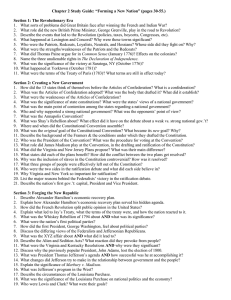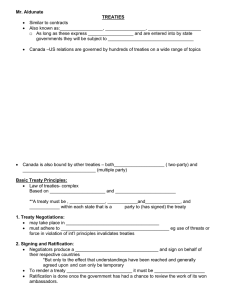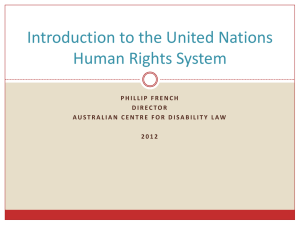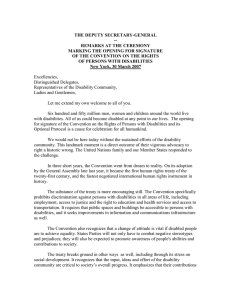Measures for ratifying and implementing the Convention
advertisement
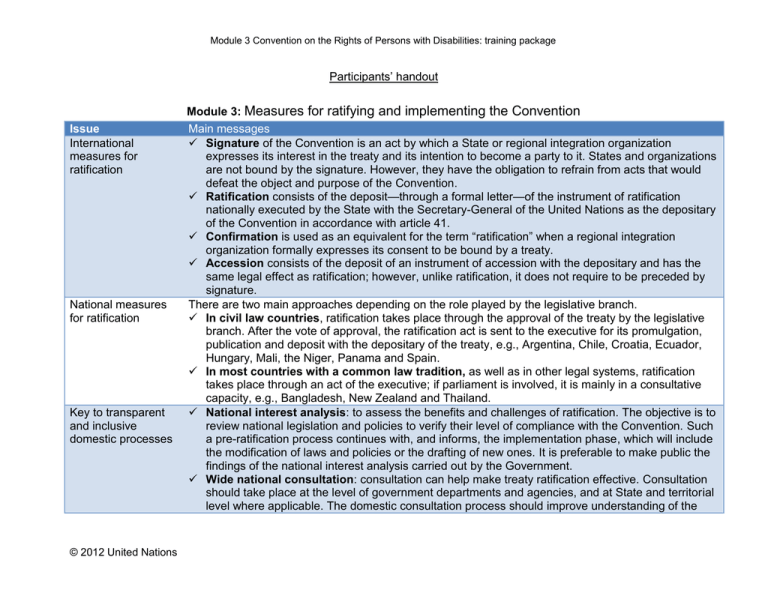
Module 3 Convention on the Rights of Persons with Disabilities: training package Participants’ handout Issue International measures for ratification National measures for ratification Key to transparent and inclusive domestic processes © 2012 United Nations Module 3: Measures for ratifying and implementing the Convention Main messages Signature of the Convention is an act by which a State or regional integration organization expresses its interest in the treaty and its intention to become a party to it. States and organizations are not bound by the signature. However, they have the obligation to refrain from acts that would defeat the object and purpose of the Convention. Ratification consists of the deposit—through a formal letter—of the instrument of ratification nationally executed by the State with the Secretary-General of the United Nations as the depositary of the Convention in accordance with article 41. Confirmation is used as an equivalent for the term “ratification” when a regional integration organization formally expresses its consent to be bound by a treaty. Accession consists of the deposit of an instrument of accession with the depositary and has the same legal effect as ratification; however, unlike ratification, it does not require to be preceded by signature. There are two main approaches depending on the role played by the legislative branch. In civil law countries, ratification takes place through the approval of the treaty by the legislative branch. After the vote of approval, the ratification act is sent to the executive for its promulgation, publication and deposit with the depositary of the treaty, e.g., Argentina, Chile, Croatia, Ecuador, Hungary, Mali, the Niger, Panama and Spain. In most countries with a common law tradition, as well as in other legal systems, ratification takes place through an act of the executive; if parliament is involved, it is mainly in a consultative capacity, e.g., Bangladesh, New Zealand and Thailand. National interest analysis: to assess the benefits and challenges of ratification. The objective is to review national legislation and policies to verify their level of compliance with the Convention. Such a pre-ratification process continues with, and informs, the implementation phase, which will include the modification of laws and policies or the drafting of new ones. It is preferable to make public the findings of the national interest analysis carried out by the Government. Wide national consultation: consultation can help make treaty ratification effective. Consultation should take place at the level of government departments and agencies, and at State and territorial level where applicable. The domestic consultation process should improve understanding of the Module 3 Convention on the Rights of Persons with Disabilities: training package Reservations and interpretative declarations Incorporation of the Convention in national systems Convention, contribute to ascertaining the compliance of laws, policies and programmes with the Convention and identify areas for improvement. Awareness-raising: ensures a good understanding of the Convention among State officers, organizations of persons with disabilities (DPOs) and civil society States may wish to adjust the application of the treaty by means of interpretative declarations or reservations. Such intention can be expressed by the State at the moment of signature, ratification or accession. The Vienna Convention on the Law of Treaties defines “reservation” as “a unilateral statement, however phrased or named, made by a State when signing, ratifying, accepting, approving or acceding to a treaty, whereby it purports to exclude or to modify the legal effect of certain provisions of the treaty in their application to that State”. Reservations cannot be incompatible with the object and purpose of the treaty. Reservations diminish the scope of protection afforded by the Convention and their scope should be restricted as much as possible. Reservations can be removed by the State party and challenged by other State parties. Two main approaches: “monist” and “dualist” countries. Monists: assume that domestic and international law form one system of law. International law does not need to be translated into national law for the treaty to be applicable. The act of ratifying the international law immediately incorporates the law into national law. International law can be directly applied by a national judge and can be directly invoked by citizens, just as if it were national law. Dualists: national and international law are separate spheres and require the translation of the latter into the former. If the country does not translate the treaty, out of negligence or because the real purpose of ratifying/acceding the treaty was merely political, the implementation of the treaty remains uncertain. The full incorporation takes place by the adoption of an act to which the Convention is attached as a schedule. © 2012 United Nations

